Table of Contents
Guide


Copyright 2016 Lin Lougheed
All rights reserved.
No part of this publication may be reproduced or distributed in any form or by any means without the written permission of the copyright owner.
All inquiries should be addressed to:
Barrons Educational Series, Inc.
250 Wireless Boulevard
Hauppauge, New York 11788
www.barronseduc.com
eISBN: 978-1-4380-6838-1
Welcome to Barrons eBook version of Writing for the IELTS! Please note that depending on what type of device you are using to view this book on, all tables, graphs, charts, passages, lists, and other illustrations may look different than the print book. Please adjust your device accordingly.
This eBook contains hundreds of hyperlinks that help you navigate through the book, bring you to helpful resources, and allow you to click between questions and answers. Good luck!

IELTS, the International English Language Testing System, is an English language proficiency exam that tests listening, reading, writing, and speaking skills. There are over 1,000 test centers in more than 140 countries around the world. Over 9,000 organizations, including universities, government agencies, and private companies, accept IELTS test scores.
There are two versions of the testAcademic and General Training. The Academic version is for students who want to pursue a university education in an English-speaking country. The General Training test is for people who need to demonstrate English language proficiency for work, training programs, secondary education, or immigration to certain countries.
This book will help you prepare for the writing section of the IELTS test whether you are planning to take the Academic or the General Training version. Both versions of the test include a writing section with two tasks.
The organization of this book follows the criteria IELTS examiners use to score your writing. If you study everything in this book, you will score well.
 Task Achievement/Task Response
Task Achievement/Task Response
 Coherence and Cohesion
Coherence and Cohesion
 Lexical Resource
Lexical Resource
 Grammatical Range and Accuracy
Grammatical Range and Accuracy
In the Task Achievement/Task Response chapter, you will learn to follow a three-step model for creating an essay:
 Plan
Plan
 Write
Write
 Revise
Revise
You will learn how to apply this model to each of the IELTS writing tasks. Study the sections of this chapter that focus on the version of the test that you plan to takeAcademic or General Training.
Each section leads you step by step through the process of writing an essay in response to that particular task. Therefore, you should work your way through each section from beginning to end. As you study a section, you will become familiar with the types of questions you will have to respond to on the IELTS. You will also learn to complete your responses within the time limits of the test.
When you respond to the IELTS writing tasks, you must write clearly, coherently, and correctly. The next three chapters of this book will help you do that. They will help you develop skills you will need for both the Academic and General Training versions of the test.
In the Coherence and Cohesion chapter, you will practice organizing your writing and connecting your ideas. In the Lexical Resource chapter, you will learn how to develop your vocabulary and use it correctly. In the Grammatical Range and Accuracy chapter, you will review grammar rules and practice applying them to your writing.
You can work through these chapters in order. Or, you can focus first on the parts that address your weakest areas. Then, you can use the rest for review and practice.
In the Appendix you will find a More Writing Practice section with a selection of essays written in response to IELTS writing tasks. You can study the essays as models of good writing. You can also use this section for further practice by writing your own responses to the tasks included in the section.
Scores for the IELTS writing tasks are reported in a scale of bands, ranging from Band 0 to Band 9. Each band represents a level of ability. Scores are based on the following criteria.
TASK ACHIEVEMENT (TASK 1): To achieve a high score, you must write a well-developed report that completely addresses all parts of the task.
TASK RESPONSE (TASK 2): To achieve a high score, you must address all parts of the task in a well-developed essay that presents a clear position supported with relevant ideas.
COHERENCE AND COHESION: To achieve a high score, your ideas and information must follow a logical organization (coherence), and you must use a range of cohesive devices skillfully.
LEXICAL RESOURCE: To achieve a high score, you must use a wide range of vocabulary fluently with few errors.
GRAMMATICAL RANGE AND ACCURACY: To achieve a high score, you must use a wide range of grammatical structures fluently and accurately with few errors.
For a complete description of the writing task bands, visit the IELTS website: http://www.ielts.org/researchers/score_processing_and_reporting.aspx#Writing
Before the test
 Practice writing within time limits. You can use the tasks in the More Writing Practice section of the Appendix for practice. Give yourself 20 minutes to complete a Task 1 response and 40 minutes to complete a Task 2 response.
Practice writing within time limits. You can use the tasks in the More Writing Practice section of the Appendix for practice. Give yourself 20 minutes to complete a Task 1 response and 40 minutes to complete a Task 2 response.
 Become familiar with word count. On the IELTS, you will write your essays by hand. You will have to write a minimum of 150 words for Task 1 and 250 words for Task 2, but you wont be able to take the time to count your words. As you practice writing essays at home, count your words. You will become familiar with what 150 words and 250 words look like in your handwriting.
Become familiar with word count. On the IELTS, you will write your essays by hand. You will have to write a minimum of 150 words for Task 1 and 250 words for Task 2, but you wont be able to take the time to count your words. As you practice writing essays at home, count your words. You will become familiar with what 150 words and 250 words look like in your handwriting.
 To prepare for Academic Task 1, take some time to study a variety of graphs, charts, and tables. You can find many on the Internet. Practice reading them and interpreting the information.
To prepare for Academic Task 1, take some time to study a variety of graphs, charts, and tables. You can find many on the Internet. Practice reading them and interpreting the information.
During the test
 Read the task carefully and make sure you understand exactly what it asks you to do.
Read the task carefully and make sure you understand exactly what it asks you to do.
 Do not copy complete sentences from the task. Paraphrase and use synonyms. You will learn how to do this in Chapters 1 and 3.
Do not copy complete sentences from the task. Paraphrase and use synonyms. You will learn how to do this in Chapters 1 and 3.
 Write in complete sentences. You can make notes in abbreviated form when you plan, but your finished essay must have complete sentences and paragraphs.
Write in complete sentences. You can make notes in abbreviated form when you plan, but your finished essay must have complete sentences and paragraphs.

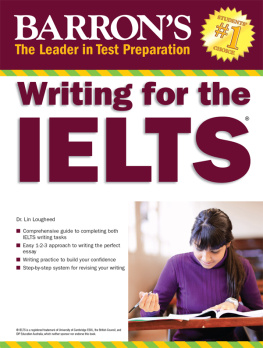



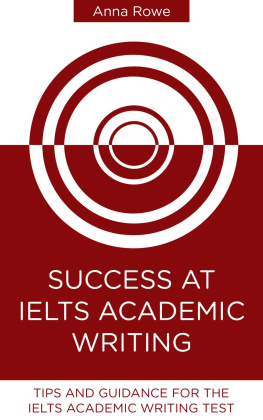
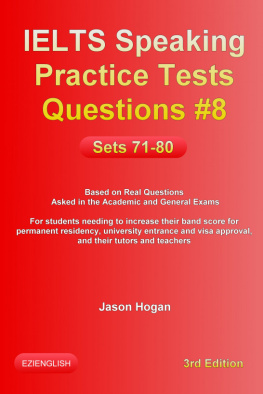


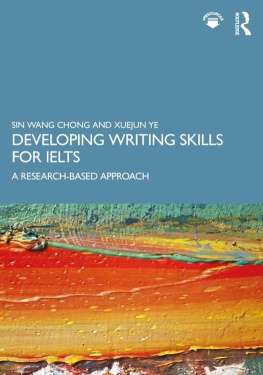


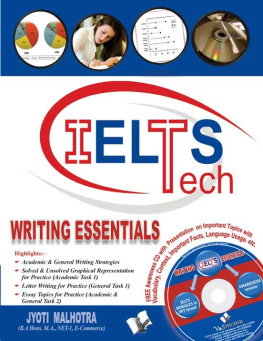
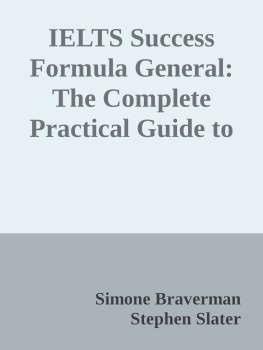



 Task Achievement/Task Response
Task Achievement/Task Response Plan
Plan Write
Write Revise
Revise